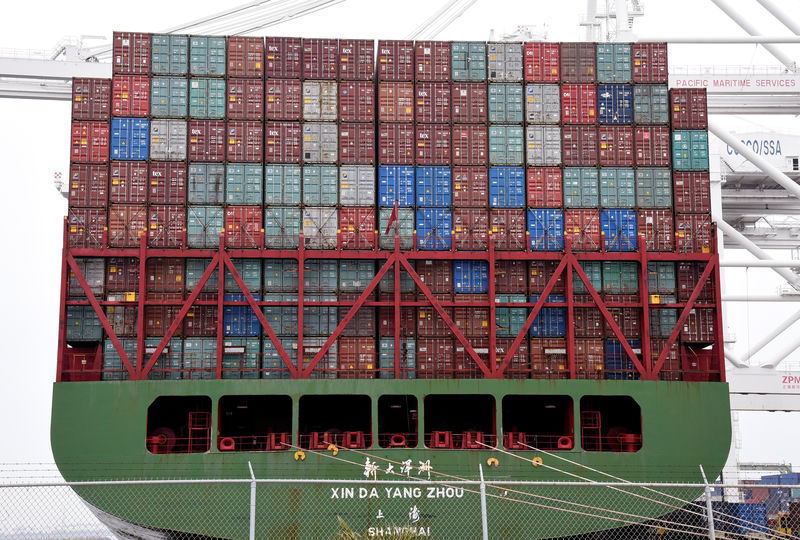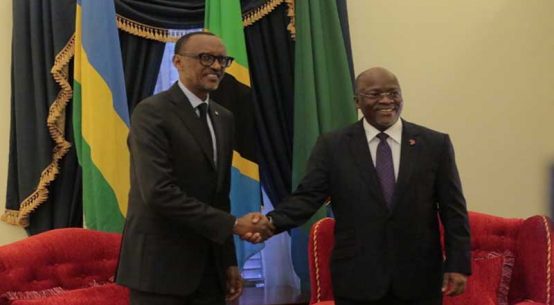
Shipping containers are being loaded onto Xin Da Yang Zhou ship from Shanghai, China at Pier J at the Port of Long Beach in Long Beach, Cali
China warns it would fight back “at any cost”
President Donald Trump on Thursday directed U.S. trade officials to identify tariffs on $100 billion more Chinese imports, upping the ante in an already high-stakes trade confrontation between the world’s two largest economies.
The further tariffs were being considered “in light of China’s unfair retaliation” against earlier U.S. trade actions, which included a proposed $50 billion of tariffs on Chinese goods, Trump said in a White House statement.
“This is what a trade war looks like, and what we have warned against from the start,” said National Retail Federation President and CEO Matthew Shay.
“We are on a dangerous downward spiral and American families will be on the losing end,” Shay added in a statement, urging Trump “to stop playing a game of chicken with the U.S. economy.”
Financial markets, roiled for days by the trade fight and Trump’s management of it, whipsawed again on the new threat. After a bullish regular trading day, U.S. equity futures sold off sharply in after-market-hours trading.
U.S. stock futures ESc1 slid 1 percent and the dollar dipped against other major currencies .DXY, while Asian shares flitted in and out of positive territory. Chinese markets were closed for a holiday.

Fight back “at any cost”
China warned on today it would fight back “at any cost” with fresh trade measures if the United States continues on its path of protectionism, hours after President Donald Trump threatened to slap an additional $100 billion in tariffs on Chinese goods.
In light of China’s “unfair retaliation” against earlier U.S. trade actions, Trump upped the ante on Thursday by ordering U.S. officials to identify extra tariffs, escalating a high stakes tit-for-tat confrontation with potentially damaging consequences for the world’s two biggest economies.
On Wednesday, China unveiled a list of 106 U.S. goods – from soybeans and whiskey to frozen beef and aircraft – targeted for tariffs, in a swift retaliatory move only hours after the Trump administration proposed duties on some 1,300 Chinese industrial, technology, transport and medical products.
Washington has called for the $50 billion in extra duties after it said a probe determined Chinese government policies are designed to transfer U.S. intellectual property to Chinese companies and allow them to seize leadership in key high-technology industries of the future.
Responding to Trump’s latest comments, the Chinese commerce ministry reiterated that China was not afraid of a trade war even though it did not seek one, and accused the United States of provoking the conflict.
“If the United States disregards the objections of China and the international community and persists in unilateralism and trade protectionism, the Chinese side will follow through to the end, at any cost, and definitely fight back resolutely,” a spokesperson was quoted as saying in a statement on the ministry’s website.
The ministry has called for a media briefing on Friday night, in an unusual move on a public holiday.
Earlier in the day, Chinese state media had slammed Trump’s threat of more trade action as “ridiculous”.
“This latest intimidation reflects the deep arrogance of some American elites in their attitude towards China,” the state-run Global Times said in an editorial.
While Beijing’s claims that Washington is the aggressor and is spurring global protectionism, China’s trading partners have complained for years that it abuses World Trade Organization rules and propagates unfair policies at home that lock foreign firms out of some sectors as domestic champions are being nurtured.
China has repeatedly vowed that it would open up sectors such as financial services.
President Xi Jinping next week is expected to unveil fresh measures on reform and his country’s opening up at the high-profile Boao Forum, China’s equivalent of Davos, in the southern island province of Hainan.
LINGERING CONCERNS
While China has projected an image of multilateralism and restraint amid the escalating trade dispute with the United States, Beijing has been swift to respond to Washington’s rhetoric and actions.
So far, U.S. information technology products from mobile phones to personal computers have largely escaped the ire of Beijing, as well as telecoms equipment and aircraft larger than the equivalent of a Boeing 737.
Among the most affected by a trade war could be the U.S. technology sector, particularly chipmakers. The U.S. semiconductor sector relies on China for about a quarter of its revenue.
It also remains to be seen if the trade dispute would trigger a nationalistic travel backlash. When ties between Beijing and Seoul chilled, Chinese tourism to South Korea plummeted and Made-in-South Korea products were shunned by consumers in China.

On Chinese social media on Friday, among the most searched phrases were “China hasn’t grown up afraid” and “China will follow through to the end.”
DAMAGING CONSEQUENCES
Analysts at Oxford Economics warned that a full-blown trade war will have damaging consequences.
“Importantly, these threatened tariffs will be subject to negotiation, and therefore shouldn’t be considered as final,” the analysts wrote in a note to client.
“A (full-blown) trade war meanwhile would have a more pronounced effect. The U.S. and China would suffer significant slowdown in real GDP growth – a cumulative loss around 1.0 percentage point,” and cut global economic growth to 2.5 percent in 2019 from 3.0 percent in Oxford’s baseline scenario.
The escalating tit-for-tat trade actions between the two economic superpowers have roiled global financial markets, as investors worried about the impact on world trade and growth, hitting equities, the dollar and a range of riskier assets such as copper and boosting safe-havens such as the Japanese yen and gold.
The dollar fell in Friday’s trade, while U.S. stock futures and most of Asia’s stock markets were in the red.
“This is what a trade war looks like, and what we have warned against from the start,” said National Retail Federation President and CEO Matthew Shay.
“We are on a dangerous downward spiral and American families will be on the losing end,” Shay added in a statement, urging Trump “to stop playing a game of chicken with the U.S. economy.”
- With reports from Reuters (Washington/Beijing)
.









